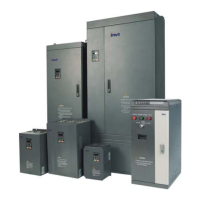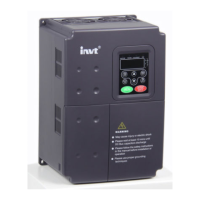What does external fault mean on INVT CHE100-2R2G-4 DC Drives?
- RRyan JacksonSep 8, 2025
If the INVT DC Drive displays an external fault, it means the external fault input terminal is active. Inspect the external equipment.
What does external fault mean on INVT CHE100-2R2G-4 DC Drives?
If the INVT DC Drive displays an external fault, it means the external fault input terminal is active. Inspect the external equipment.
What causes current detection fault in INVT DC Drives?
If the INVT DC Drive displays a current detection fault, it could be due to loose wires or connectors on the control board, a damaged Hall sensor, or an abnormal amplifying circuit. Check the wiring.
How to fix autotuning fault in INVT CHE100-2R2G-4 DC Drives?
If the INVT DC Drive displays an autotuning fault, it could be due to improper settings of the motor's rated parameters or the autotuning process timing out. Set the rated parameters according to the motor nameplate and check the motor’s wiring.
What does EEPROM fault mean in INVT DC Drives?
If the INVT DC Drive displays an EEPROM fault, it indicates a read/write fault of control parameters. Press STOP/RESET to reset.
What causes PID feedback fault in INVT CHE100-2R2G-4?
If the INVT DC Drive displays a PID feedback fault, it could be due to a disconnected PID feedback or a disappearing PID feedback source. Inspect the PID feedback signal wire and the PID feedback source.
How to troubleshoot brake unit fault in INVT CHE100-2R2G-4 DC Drives?
If the INVT DC Drive shows a brake unit fault, it could be due to braking circuit failure, a damaged brake tube, or too low resistance of the externally connected braking resistor. Inspect the braking unit and replace the braking tube if necessary. Increase the braking resistance.
Illustrates the overall wiring diagram for connecting external devices.
Shows the layout and labels of main circuit terminals for different inverter sizes.
Details the connection points and functions of control circuit terminals.
Presents a general wiring diagram for inverter connections with external components.
Lists specifications for breakers, cables, and contactors for various models.
Provides specifications for AC input, AC output, and DC reactors.
Lists specifications for braking units and resistors, including order numbers.
Covers connections for breakers, contactors, AC reactors, and EMC filters.
Details wiring for DC reactors and braking units.
Explains connections for output reactors and output EMC filters.
Describes the wiring for a regenerative unit used for braking.
Explains the common DC bus method for multi-motor applications.
Provides guidelines for proper grounding of the inverter for safety.
Offers recommendations for connecting control terminals and using shielded cables.
Lists terminal symbols and their functions for control circuits.
Emphasizes the importance and methods of grounding for EMC and safety.
Guides the user through the process of setting inverter parameters via menus.
Explains how to reset faults after an error occurs.
Describes the procedure for tuning motor parameters for optimal performance.
Mentions the availability of fault information.
Explains basic functions like control mode and run command source.
Sets the inverter's control mode (SVC, V/F, Torque).
Selects the source for run commands (keypad, terminal, communication).
Defines the source for the frequency command.
Sets the maximum output frequency limit.
Sets the upper limit for the output frequency.
Sets the lower limit for the output frequency.
Defines the acceleration time from 0Hz to max frequency.
Defines the deceleration time from max frequency to 0Hz.
Sets the carrier frequency for PWM output.
Initiates motor parameter autotuning.
Parameters for controlling motor start and stop operations.
Selects the starting method (direct start or DC braking start).
Sets the initial frequency for motor start.
Sets the duration for holding the starting frequency.
Sets the DC braking current level before starting.
Sets the duration for DC braking before starting.
Selects the stop method (deceleration or coast to stop).
Sets the frequency at which DC braking starts.
Sets a delay before DC braking begins.
Specifies the DC braking current value.
Sets the duration for DC braking.
Parameters for configuring motor characteristics for optimal performance.
Sets the motor's rated power.
Sets the motor's rated frequency.
Sets the motor's rated speed.
Sets the motor's rated voltage.
Sets the motor's rated current.
Sets the motor's stator resistance.
Sets the motor's rotor resistance.
Sets the motor's leakage inductance.
Sets the motor's mutual inductance.
Sets the motor's current without load.
Sets the proportional gain for the Auto-tuning Speed Regulator (ASR).
Sets the integral time for the ASR.
Defines the frequency point for switching ASR parameters.
Sets the second proportional gain for ASR.
Sets the second integral time for ASR.
Defines the second frequency point for ASR parameter switching.
Adjusts slip compensation for vector control to improve speed precision.
Records the most recent fault types for troubleshooting.
Records operational data (frequency, current, voltage) at fault.
Records input terminal status during a fault.
Records output terminal status during a fault.
Lists common fault codes, their reasons, and solutions.
Details common operational faults and their troubleshooting steps.
Troubleshoots issues where the display is off after powering on.
Addresses tripping of the power supply air switch upon startup.
Solves problems where the motor does not run after the inverter is on.
Troubleshoots input side switch tripping during inverter operation.
Outlines maintenance procedures and precautions.
Lists parameters for motor setup (P2.00-P2.10).
Lists parameters for vector control (P3.00-P3.07).












